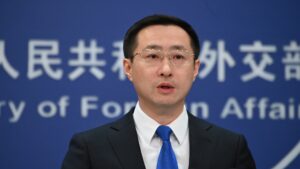Understanding the Evolving U.S.-China Trade Relations: A Deep Dive from Extreme Investor Network
The Current Landscape of Tariffs and Trade Wars
As the world’s two largest economies, the United States and China have long been locked in a tense economic rivalry. A recent escalation came to light on March 4, 2025, during a press briefing by Lin Jian, spokesperson for the Chinese Foreign Ministry. Lin stated that China is ready to employ "resolute and forceful" measures to protect its economic interests following the implementation of exorbitant tariffs—totaling 104%—on Chinese imports to the U.S.
This dramatic shift has drawn the ire of Beijing, which asserts that these tariffs reflect unilateralism and economic bullying tactics on the part of the U.S. The heightened tension marks a significant turning point, following the recent announcement from China’s Finance Ministry imposing additional tariffs of 34% on all U.S. goods starting April 10—a move aimed at retaliating against prior U.S. tariffs.
The Economic Repercussions
Experts, such as Dan Wang from Eurasia Group, have pointed out the potential fallout from these measures. Wang indicates that tariffs exceeding the 35% threshold could render Chinese exports to the U.S. unviable, effectively leading to a halt in trade. This indicates that the stakes are high, and both countries are poised for a long, contentious battle over tariffs and market access.
The situation is further complicated by the global supply chain’s intricate nature. Tariffs imposed by one nation can lead to extensive repercussions, not just for the immediate parties involved, but for global markets as a whole. This cyclical pattern of retaliation can cause inflationary pressures and destabilize financial markets in unpredictable ways.
A Call for Dialogues
Despite the rising tensions, Lin emphasized the importance of dialogue and negotiation, urging the U.S. to adopt an attitude of mutual respect and benefit. This sentiment seems to mirror China’s consistent offer to engage in collaborative discussions to resolve economic disputes. The Chinese government remains hopeful that the U.S. will consider lifting unilateral trade barriers, aiming toward a potential pathway for cooperation.
However, the history of U.S.-China negotiations has often been fraught with complications. The "Phase 1" trade deal—a pivotal agreement struck during the Trump administration—was aimed at ramping up Chinese purchases of U.S. goods. Yet, many of the targets set within this deal were not met, in part due to the severe economic disruptions caused by the COVID-19 pandemic. China alleges it has adhered to the agreement’s terms, while claiming that the U.S. has failed in various respects, further complicating the narrative surrounding trade compliance.
Conclusion: What Lies Ahead?
As this economic saga continues to unfold, the implications for global markets, inflation, and financial stability cannot be overstated. At Extreme Investor Network, we believe in empowering our readers with critical insights and actionable information. Understanding the intricacies of U.S.-China trade relations is essential for investors and businesses alike as they navigate these turbulent waters.
Stay engaged with us as we continue to provide the latest updates and expert analysis on economic trends, helping you make informed decisions in an ever-changing financial landscape. Don’t miss out on future insights that can position you for success in this complex market!

